 Most fencers consider their first fencing gear to be the sweat clothes and athletic shoes that they dress in for their initial lesson. Some of this equipment is borrowed from the club, and some is purchased by the fencer. The USFA requires that all fencers participating in tournaments wear regulation garments: masks, gloves, jackets, chest plates, plastrons, and knickers. While most clubs require students to provide their own gear, in the interest of making fencing affordable for all students, Lincoln Fencing Club provides jackets, masks, chest plates, plastrons, and weapons for students. Gloves are also available, although most students purchase their own. Knickers are not required to participate in classes at LFC; however, there are some available for students’ use.
Most fencers consider their first fencing gear to be the sweat clothes and athletic shoes that they dress in for their initial lesson. Some of this equipment is borrowed from the club, and some is purchased by the fencer. The USFA requires that all fencers participating in tournaments wear regulation garments: masks, gloves, jackets, chest plates, plastrons, and knickers. While most clubs require students to provide their own gear, in the interest of making fencing affordable for all students, Lincoln Fencing Club provides jackets, masks, chest plates, plastrons, and weapons for students. Gloves are also available, although most students purchase their own. Knickers are not required to participate in classes at LFC; however, there are some available for students’ use.
Although injuries are uncommon in fencing—due in part to protective gear required by the sport—they do occasionally happen. If a student is not using knickers, LFC requires that durable long pants should be worn to all classes and lessons. Athletic wear like sweatpants and lined nylon warm-up pants are recommended; jeans or denim pants are discouraged because they do not allow freedom of movement. Socks must be worn, preferably athletic socks. Court-style athletic shoes are preferred. No slip-on shoes, sandals, or open-toed shoes are allowed. If a student is not wearing proper footwear, long pants, or socks and is injured during practice, class, or a lesson, LFC cannot be held responsible. Please make sure to wear appropriate clothing to class, practice, and lessons to minimize the chance of injury.
A natural question, then, is what to purchase when starting to build your personal cache. LFC offers the following advice in response to this inquiry:
- After about 6 months of fencing, most athletes begin their collection of gear with a glove and mask. Obtaining these items provides you with foundational pieces of safety, while offering the privilege of enjoying only your own sweat. Further, you can be assured that what you own will fit you. You must specify whether you are right or left handed when ordering the glove, and decide which size fits you best. The mask size must also be specified. Trying on these pieces at club to determine your size is suggested. Also note that the foil and epee masks are so similar that most people buy the two-weapon mask. Sabre, by definition, is a mask of a different style and should be purchased only if you are specializing in this weapon.
- Once the wallet has been replenished, many fencers choose an electric weapon and one or two body cords as the next purchase. You must again specify right or left handed and the size/style of the grip. The size of the blade varies by age category so you may want to confer with your coach as to the advisable length/size. Most of LFC uses 2-prong body cords, so you will find it more convenient to buy weapons and body cords of this type. It provides more flexibility should you need to borrow equipment.
- Next, a good pair of knickers, jacket, and plastron are desirable. Women additionally buy a chest protector at this stage. As with all of the equipment, FIE is necessary only if you are going to fence in international events. Many fencers start with a set that is less expensive than FIE. If you are going to a tournament where vendors will be displaying goods, you may want to try on the different styles and sizes of uniforms. You can purchase during the event, or just use it as a research opportunity and order off the web. It is a requirement to wear your last name on the knickers or the lame’/jacket. Some people use home-made methods to accomplish this and others pay vendors to do so. Either way, many prefer the name on the knickers. This eliminates the need to label multiple jacket/lame’ combinations for various weapons. The knickers last longer than do lame’s, so it is a bit more economical as well.
- Finally, the lame’ completes the basics. A well-fit lame’, in good shape, helps to assure integrity in a foil or sabre bout. The foil lame’ is typically purchased first. Like the sabre mask, the sabre lame’ is typically an early purchase only if you are specializing in this weapon. Those specializing in sabre will often purchase the mask cord and gauntlet simultaneously with the lame’.
- Assorted other items can be purchased after the basics. Some prefer to buy actual fencing shoes vs. general athletic shoes. The key to a good shoe for fencing is one that is not too bulky in the sole but provides ample cushioning in the heel. It should provide good support to the whole foot. Some people enjoy court or running shoes and others prefer wrestling styles.
Note: There are currently 20 major vendors of fencing equipment. You can access these at http://www.usfencing.org/ under Info for Members, Equipment Vendors.
No matter whether your equipment is from your own private gear or is provided by the club, you will want to be sure to have it well organized for practice and tournaments. Be sure to put your name on all personal equipment, and use the packing list when preparing for tournaments. Click Here for LFC Packing List. Once you’ve arrived, you will be glad that you geared up!
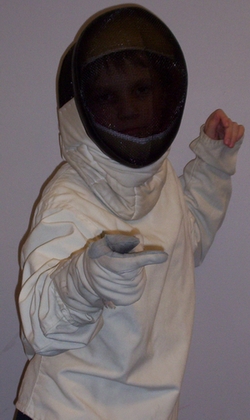
Jacket, mask, and glove.
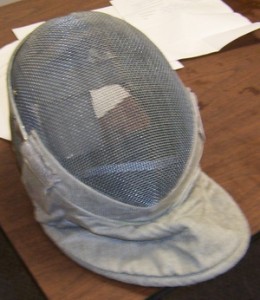
A sabre mask. It is silvery, to register scoring electronically, as the head is a target in sabre.
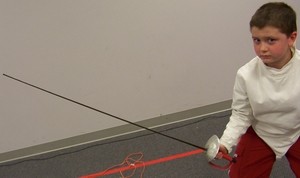
A sabre being held.
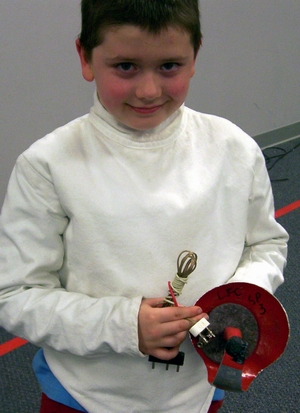
A sabre’s grip and body cord. The sabre grip is designed to protect the hand from the slashing attacks of sabre.
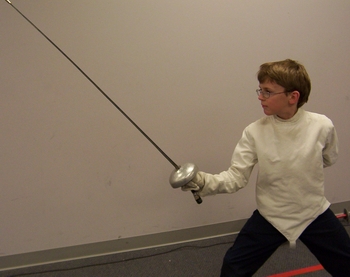
An epee being held.
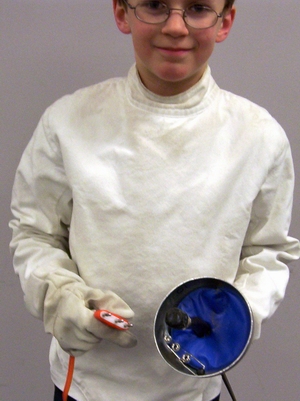
An epee grip and body cord. The epee’s larger guard, called a bell, is to protect the hand, which is a target in epee.
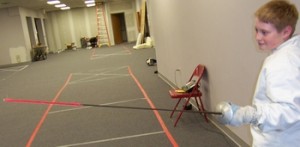
A foil being held.
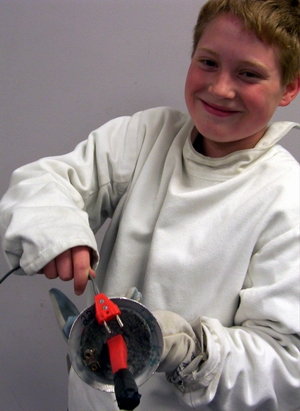
A foil grip and body cord. The foil guard is smaller, as the hand is not a target in foil.
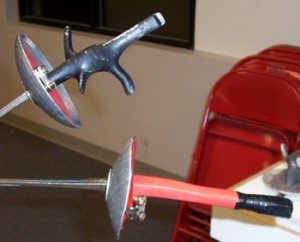
Two foil grips. Above is the pistol grip, a more ergonomic handle that many prefer. Below is the traditional French grip.
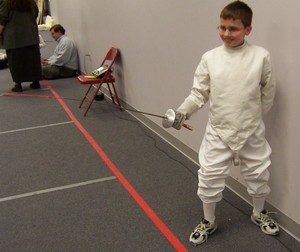
A full fencing outfit, without mask. Jacket, glove, knickers, socks covering the shins, and athletic shoes.
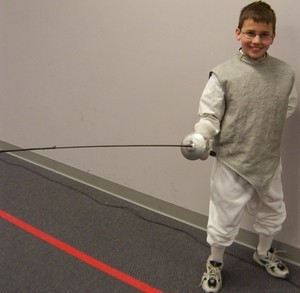
A full fencing outfit, without mask, and with a lame for foil fencing. The silvery material helps register touches electronically. The lame covers all parts considered targets in foil fencing.
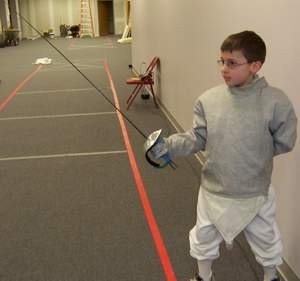
A full sabre outfit, without mask. The silvery material helps register touches electronically. The lame covers all parts considered targets in sabre fencing, including arms. The sabre mask is also covered with this material, as the head is also a target.
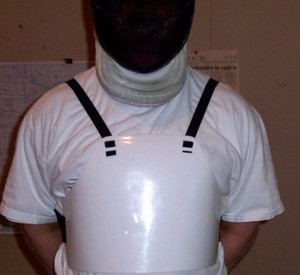
Men’s chest protector. While not required, many fencers wear them for extra protection.
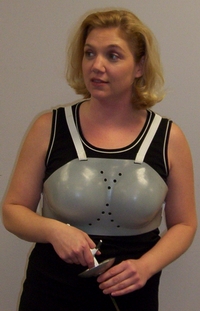
Women’s breast protector. The plastic protection is required for all female fencers.
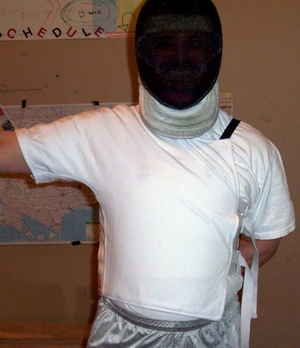
A plastron. This extra protection covers the side of the body of the fencer’s weapon hand. Required in some tournaments, many fencers wear them even when not required, for extra safety.